Pump Handbook by Igor J. Karassik, Joseph P. Messina, Paul Cooper, Charles C. Heald - 3rd edition
Подождите немного. Документ загружается.

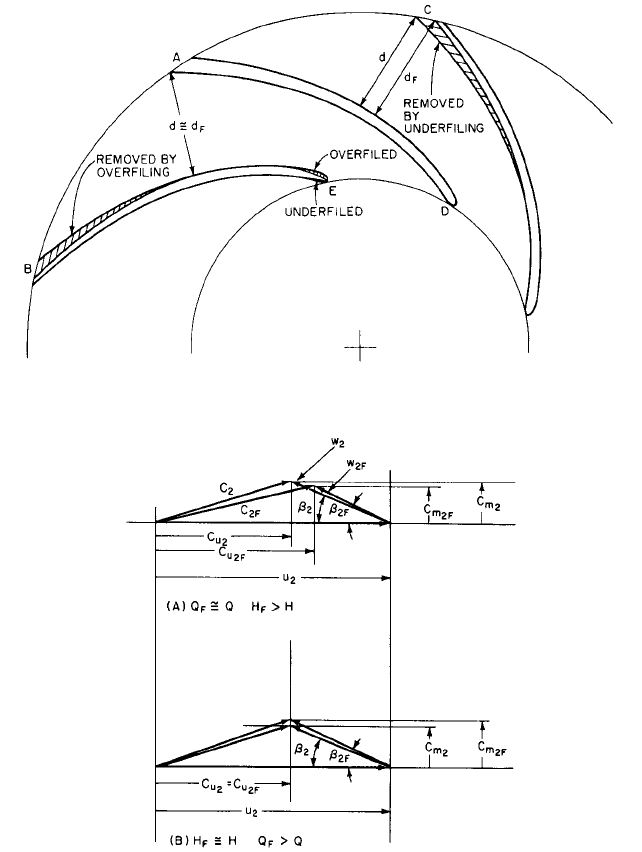
2.3.1 CENTRIFUGAL PUMPS: GENERAL PERFORMANCE CHARACTERISTICS 2.345
FIGURE 17 Underfiling and overfiling of blade tips
FIGURE 18 Discharge velocity triangles for underfiled blades (neglecting slip)
INLET BLADE TIPS
If the inlet blade tips are blunt, as shown at D in Figure 17, the cavita-
tion characteristics may be improved by sharpening them, as shown at E. In this case
overfiling increases the effective flow area, which reduces c
m1
for a given flow rate. If more
area is needed, it may be advantageous to cut back part of the blade and sharpen the lead-
ing edge. Overfiling tends to increase b
1
, which is incompatible with a decrease in c
m1
(Fig-
ure 19). The increase in b
1
increases the angle of attack of the liquid approaching the
blade. In Figures 2 and 19, w
1
is tangent to the centerline of the blade at entrance and w
0
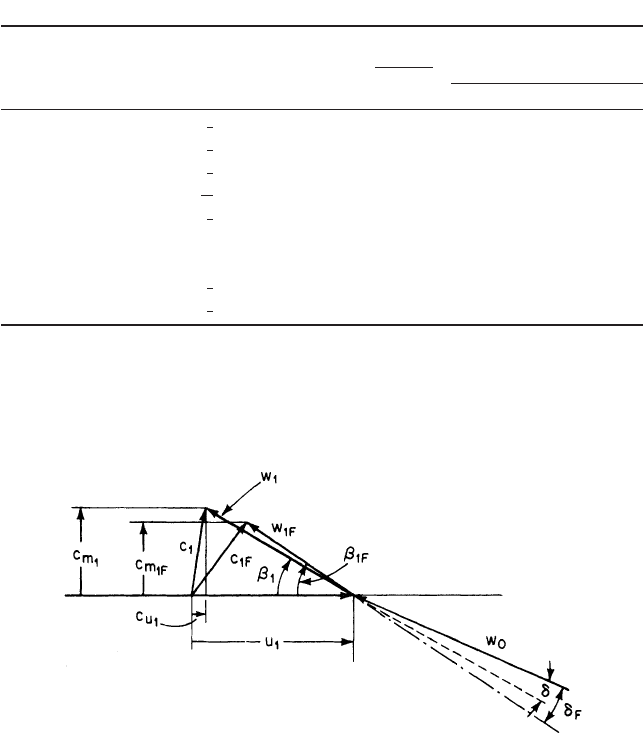
2.346 CHAPTER TWO
TABLE 7 Changes in performance when impeller blades are underfiled
Change
Impeller in blade
Changes at best efficiency
Specific speed No. of diameter D
2,
spacing
point after filing, %
n
s
s
stages in (cm) d
F
/d%
b
H
o
c
HQP h
862 (0.3154) 1 11 (29.21) 1.13 4 1.5 4 0 9 5
945 (0.3458) 2 8 (21.27) 1.05 5.5 0 3 4 0.5 7.5
d
1000 (0.3659) 4 9 (23.18) 1.055 5.5 0 5.5 0 3 2.5
1080 (0.3952) 2 9 (24.92) 1.08 10 2.5 10 0 6.8 3
1525 (0.5580) 2 10 (26.67) 1.035 3.2 3 0.5 4.5 3.5 1.2
1950 (0.7135) 1 22 (55.88) 1.02 1.5 1 1.5 0 1.5 0
3300
a
(1.2075) 1 12 (30.48) . . . 7.8 2.5 7.8 0 8.5 0.6
3450
a
(1.2623) 1 30 (77.47) . . . 6.5 0.5 6.5 0 7.8 2.2
4300 (1.5734) 1 41 (104.8) . . . 5 5 0 0.5 4.5
e
a
Double suction.
b
H
F
is head after filing.
c
Shutoff head.
d
Due in part to changes in pump casing.
e
Due in part to rounding of inlet blade tips.
Source: Flowserve Corporation
1
4
1
2
1
2
13
16
1
8
3
8
1
2
H
F
H
H
FIGURE 19 Effect of overfiling at inlet on the velocity triangle just inside the blades
is the velocity of the approaching liquid as seen by an observer moving with the blade.
The angle d between w
0
and w
1
is the angle of attack, which increases to d
F
after overfil-
ing. Although the increase in d tends to increase the opportunity for the liquid to sepa-
rate from the low-pressure face of the blade, this disadvantage usually is outweighed by
the improvement that results when c
m1
is reduced.*
1
*The distinction between a true velocity diagram formed just upstream of the impeller blades and the triangles shown
just inside the blades in Figure 19 should be noted. w
1
in this figure is shown aligned with the blade, having undergone an
adjustment in direction via incidence from that of the approaching w
0
. Only by plotting the velocity diagram just upstream
of this point can one determine the true value of the circumferential component c
u1
of the absolute velocity being delivered
to the impeller by the upstream piping, vanes, and so on. It is this delivered value of c
u1
that must be used in computing
input or ideal head of the impeller (Eq. 15b, Section 2.1 or, neglecting slip, Eq. 6 of this subsection).Thus w
0
is properly the
true w
1
vector and should be understood as such (see Section 2.1).

2.3.1 CENTRIFUGAL PUMPS: GENERAL PERFORMANCE CHARACTERISTICS 2.347
CASING TONGUE The casing tongue or cutwater forms part of the throat of the discharge
nozzle of many volute casings (Figure 20a, Section 2.1). Frequently the throat area is small
enough to act as a throttle and reduce the maximum flow rate otherwise obtainable from
the impeller. Cutting back the tongue increases the throat area and increases the maxi-
mum flow rate. The head-versus-flow rate characteristic is then said to carry out farther.
Shortening the discharge nozzle may increase the diffusion losses a little and result in a
slightly lower efficiency.
CAVITATION _________________________________________________________
The formation and subsequent collapse of vapor-filled cavities in a liquid due to dynamic
action are called cavitation. The cavities may be bubbles, vapor-filled pockets, or a combi-
nation of both. The local pressure must be at or below the vapor pressure of the liquid for
cavitation to begin, and the cavities must encounter a region of pressure higher than the
vapor pressure in order to collapse. Dissolved gases often are liberated shortly before
vaporization begins.This may be an indication of impending cavitation, but true cavitation
requires vaporization of the liquid. Boiling accomplished by the addition of heat or the
reduction of static pressure without dynamic action of the liquid is arbitrarily excluded
from the definition of cavitation.
When a liquid flows over a surface having convex curvature, the pressure near the sur-
face is lowered and the flow tends to separate from the surface. Separation and cavitation
are completely different phenomena. Without cavitation, a separated region contains tur-
bulent eddying liquid at pressures higher than the vapor pressure. When the pressure is
low enough, the separated region may contain a vapor pocket that fills from the down-
stream end,
15
collapses, and forms again many times each second. This causes noise and,
if severe enough, vibration. Vapor-filled bubbles usually are present and collapse very
rapidly in any region where the pressure is above the vapor pressure. Knapp
16
found the
life cycle of a bubble to be on the order of 0.003 s.
Bubbles that collapse on a solid boundary may cause severe mechanical damage. Shut-
ler and Mesler
17
photographed bubbles that distorted into toroidal-shaped rings during col-
lapse and produced ring-shaped indentations in a soft metal boundary. The bubbles
rebounded following the initial collapse and caused pitting of the boundary. Pressures on the
order of 10
4
atm have been estimated
18
during collapse of a bubble.All known materials can
be damaged by exposure to bubble collapse for a sufficiently long time.This is properly called
cavitation erosion, or pitting. Figure 20 shows extensive damage to the suction side of pump
impeller vanes after about three months’ operation with cavitation.At two locations, the pit-
ting has penetrated deeply into the -in (9.5-mm) thickness of stainless steel. The unfavor-
able inlet flow conditions, believed to have been the cause of the cavitation, were at least
partly due to elbows in the approach piping. Modifications in the approach piping and the
pump inlet passages reduced the cavitation enough to extend impeller life to several years.
19
It has been postulated that high temperatures and chemical action may be present at
bubble collapse, but any damaging effects due to them appear to be secondary to the
mechanical action. It seems possible that erosion by foreign materials in the liquid and cav-
itation pitting may augment each other. Controlled experiments
20
with water indicated that
the damage to metal depends on the liquid temperature and was a maximum at about 100
to 120°F (38 to 49°C). Cavitation pitting, as measured by weight of the boundary material
removed per unit time, frequently increases with time. Cast iron and steel boundaries are
particularly vulnerable. Controlled experiments have shown that cavitation pitting in met-
als such as aluminum, steel, and stainless steel depends strongly on the velocity of the fluid
in the undisturbed flow past the boundary. On the basis of tests of short duration, Knapp
15
reported that damage to annealed aluminum increased approximately as the sixth power of
the velocity of the undisturbed flow past the surface. Hammitt
21
found a more complicated
relationship between velocity and damage, as shown in Figure 21. It seems clear that after
cavitation begins, it will increase rapidly with increasing velocities. Frequently the rate of
pitting accelerates with elapsed time. Comprehensive discussions of cavitation and erosion
together with additional references are given by Preece.
22
3
8
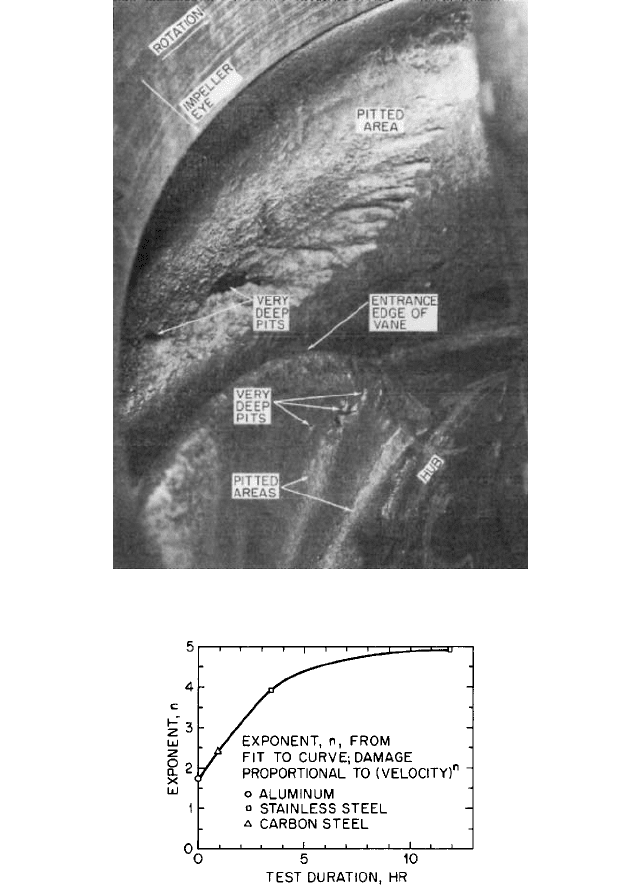
2.348 CHAPTER TWO
FIGURE 20 Impeller damaged by cavitation (Demag Delaval, Reference 19)
FIGURE 21 Cavitation damage exponent versus test time for several materials in water (Reference 21)
Centrifugal pumps begin to cavitate when the suction head is insufficient to maintain
pressures above the vapor pressure throughout the flow passages. The most sensitive
areas usually are the low-pressure sides of the impeller vanes near the inlet edge and the
front shroud, where the curvature is greatest. Axial-flow and high-specific-speed
impellers without front shrouds are especially sensitive to cavitation on the low-pressure
2.3.1 CENTRIFUGAL PUMPS: GENERAL PERFORMANCE CHARACTERISTICS 2.349
sides of the vane tips and in the close tip-clearance spaces. Sensitive areas in the pump
casing include the low-pressure side of the tongue and the low-pressure sides of diffusion
vanes near the inlet edges. As the suction head is reduced, all existing areas of cavitation
tend to increase and additional areas may develop. Apart from the noise and vibration,
cavitation damage may render an impeller useless in as little as a few weeks of continu-
ous operation. In multistage pumps cavitation usually is limited to the first stage, but
Kovats
23
has pointed out that second and higher stages may cavitate if the flow is reduced
by lowering the suction head (submergence control). Cavitation tends to lower the axial
thrust of an impeller. This could impair the balancing of multistage pumps with opposed
impellers. A reduction in suction pressure may cause the flow past a balancing drum or
disk to cavitate where the liquid discharges from the narrow clearance space. This may
produce vibration and damage resulting from contact between fixed and running surfaces.
Net Positive Suction Head (NPSH) Several criteria exist for establishing the NPSH
of a pump. These are connected with a) inception of cavitation, b) loss of hydraulic per-
formance, and c) protecting the pump against cavitation erosion or damage. These are
defined and found as follows:
a. Inception NPSH. Cavitation can be completely prevented so long as the static
pressure within the pump is everywhere greater than the vapor pressure of the liquid.
This can be achieved if the NPSH (also called h
sv
), defined in Section 2.1 as the total
head of the pumped liquid at the pump inlet datum or suction flange above that vapor
pressure, is sufficiently large. The value of NPSH that achieves this is called NPSH
i
,
namely, the “inception NPSH.”
b. Performance NPSH. In a typical NPSH-test at constant speed n and flow rate Q,a
substantial reduction of NPSH below NPSH
i
is usually necessary to reach the value
that produces an identifiable drop in performance
—
usually 3% of pump stage total
pressure rise or pump head. This value is called the “required NPSH,” NPSHR or
NPSH
3%
. Table 1 in Section 2.1 provides empirical correlations for NPSH
3%
for com-
mon pumps and inducers. Other criteria for NPSH
3%
will be given further on. The
domains of cavitation within a pump are widespread at this condition, and experience
shows that a head drop in the neighborhood of 3% must occur in order to obtain a
repeatable value of NPSHR on test
12
. Lower percentages have been demanded by
users, but they invariably give rise to a large scatter in the measured NPSHR for even
small variations in any of the test variables.
It used to be thought throughout the pump community that there are no cavities or
bubbles present at zero percent head drop due to cavitation activity within a pump. In
recent decades, however, it has been proven through many observations that not only
is the head drop equal to zero at inception (where NPSH NPSH
i
), it remains so for
an enormous range of lesser NPSH-values over which extensive bubble activity is
observed. In fact, NPSH
i
is commonly from two to five times the magnitude of the
NPSHR that is associated with any noticeable drop in pump head. At the 3% (or lesser
percentage) head drop condition, actual observations of the cavitating flow show the
cavities to extend all the way from the leading edge of each blade to the throat formed
by the leading edge of the next blade
24
. In the face of these learnings, it is evident that
to demand a test for the NPSH required for a head drop of much less than 3% usually
causes only needless misunderstandings and expenditure of time and money.
c. Damage-Limiting NPSH or Life NPSH. If it is desired to substantially reduce or
eliminate cavitation activity within the pump, an acceptance test should be conducted
wherein the cavitating flow can be observed visually
25
. This is indeed a serious issue
if the pump energy level is high enough (and therefore the inlet pressure) for the
collapsing cavities to do damage (as in Figure 20; see also Section 2.1). In such a case,
“NPSH
3%
” has virtually no meaning; rather, the truly required NPSH or “NPSHR” is
that larger value which satisfactorily limits the extent of this visually observed
cavitation within the pump or pump model
26
.
Therefore, the available NPSH at the installation must be at least equal to the
required NPSH if the above consequences are to be avoided
—
be they significant loss of
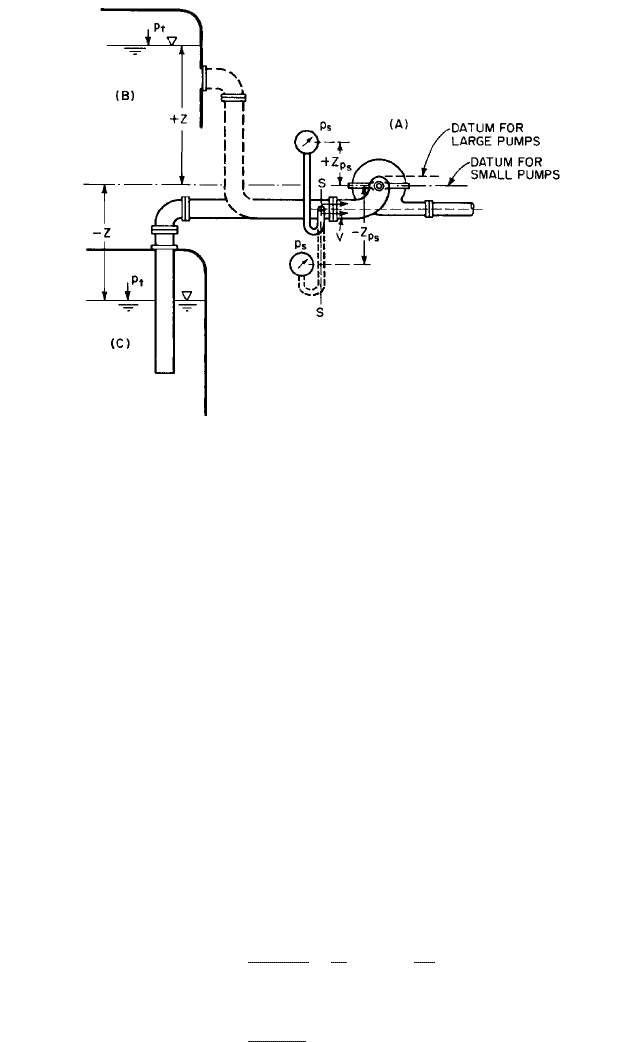
2.350 CHAPTER TWO
FIGURE 22 Definition sketch for computing NPSH
pump head (that is, loss of hydraulic performance) or damage due to collapsing cavities.
Increasing the available NPSH above the required value provides a margin of safety
against unpredictable variations of conditions, including transient behavior. Figure 22
and the following symbols will be used to compute the available NPSH:
p
a
absolute pressure in atmosphere surrounding gage, Figure 22
p
s
gage pressure indicated by gage or manometer connected to pump suction
at section s-s; may be positive or negative
p
t
absolute pressure on free surface of liquid in closed tank connected to
pump suction
p
vp
vapor pressure of liquid being pumped corresponding to the temperature at
section s-s (if liquid is a mixture of hydrocarbons, p
vp
must be measured by
the bubble point method)
h
f
lost head due to friction in suction line between tank and section s-s
V average velocity at section s-s
Z, Z
ps
vertical distances defined by Figure 22; may be positive or negative
g specific weight of liquid at pumping temperature
It is satisfactory to choose the datum for small pumps as shown in Figures 1 and 22,
but with large pumps, the datum should be raised to the elevation where cavitation is
most likely to start. For example, the datum for a large horizontal-shaft propeller pump
should be taken at the highest elevation of the impeller-blade tips. The available NPSH is
given by
(15)
or
(16) h
sv
p
t
p
vp
g
Z h
f
h
sv
p
a
p
vp
g
p
s
g
Z
ps
V
2
2g
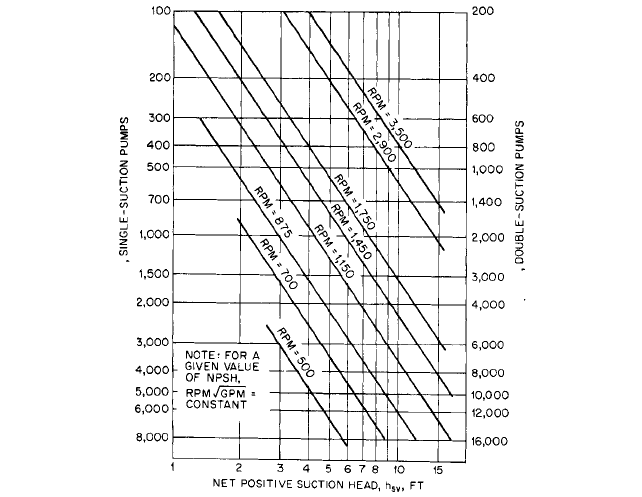
2.3.1 CENTRIFUGAL PUMPS: GENERAL PERFORMANCE CHARACTERISTICS 2.351
Consistent units must be chosen so that each term in Eqs. 15 and 16 represents feet (or
meters) of the liquid pumped. Equation 15 is useful for evaluating the results of tests. Equa-
tion 16 is useful for estimating available NPSH during the design phase of an installation.
In Eq. 15, the first term represents the height of a liquid barometer, h
b
, containing the liquid
being pumped and the sum of the remaining terms represents the suction head h
s
; that is,
the total head H (Eq. 3, Section 2.1) evaluated at the suction flange S in Figure 22. Therefore
(17)
Usually, a positive value of h
s
is called a suction head and a negative value of h
s
is called
a suction lift.
Many pumps draw cold water from reservoirs exposed to atmospheric pressure, so the
suction lift is limited if there is to be a reasonable value of h
sv
( NPSH) available at the
pump suction flange or port. In normal practice, rather small values of suction lift or suc-
tion head are encountered in many installations, so one can depend on the value of h
sv
being a substantial portion of h
b
—
say about 60% or 20 ft (6m) of water column. Recogniz-
ing that the suction specific speed capability S of most pumps falls within a rather small
range has led to charts of recommended operating speeds such as those in Section 9.10 or
the speed recommendations of Figure 23 for condensate pumps for varying amounts of
NPSH available. In fact, S 8500 (
ss
3.11) is recommended by the Hydraulic Insti-
tute
27
. S ( N
ss
) and
ss
are defined in Eqs. 41 and 42 of Section 2.1. The relationship of
suction-specific speed to other suction parameters is treated further on.
Cavitation Tests In addition to the constant-Q tests for NPSHR that were described in
the foregoing review of the various NPSH-criteria, one can establish the curve of perfor-
mance NPSH versus flow rate by varying the NPSH available and seeing how much flow
h
sv
h
b
h
s
FLOW RATE Q, GPM
FLOW RATE Q, GPM
FIGURE 23 Capacity (flow rate) and speed limitations for condensate pumps with shaft through eye of impeller
(ft 0.3048 m; gpm 0.06309 = l/s) (adapted from Hydraulic Institute ANSI/HI 2000 Edition Pump Standards,
Reference 27)
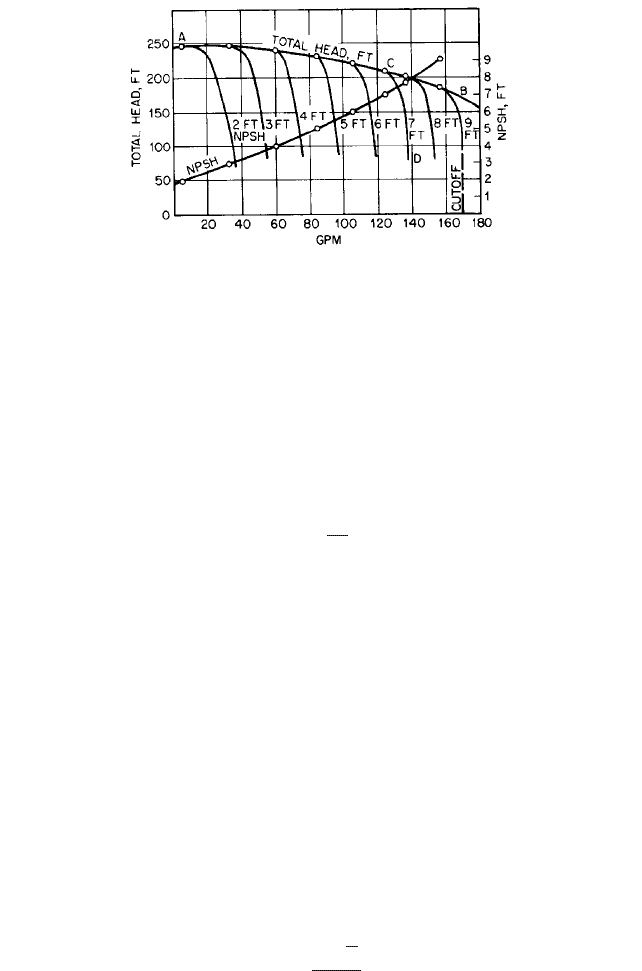
2.352 CHAPTER TWO
FIGURE 24 Test of a 1.5-in (3.81-cm) single-stage pump at 3470 rpm, on water, 70ºF (2lºC) (ft 0.3048 = m; gpm
0.06309 = l/s) (Reference 12)
rate Q the pump can handle. This is illustrated in Figure 24, wherein a different head
curve is found for each value of NPSH. For each such curve, as Q is increased, there is a
point at which the head departs from the next one of higher NPSH. This, then, is the Q
for which the given NPSH is that required to maintain head, essentially NPSH
3%
.At
higher flow rate, performance is lost, each head curve possessing a “cutoff” flow rate. Ref-
erences 27 and 28 may be consulted for details of test procedures.
Thoma Cavitation Parameter S All the terms in Eqs. 15 to 17 may be made dimension-
less by dividing each by the pump head H. The resulting parameter
(18)
has proven to be useful especially for high-specific speed pumps and turbines.The loading
on the blades of a variable-pitch propeller, and therefore the minimum suction-side static
pressure, is directly connected to the head developed. As this head increases with increas-
ing blade setting angle, the loading increases, the minimum pressure drops, and the
NPSHR goes up. Hence an identifiable limiting value of s is found to exist for such a
machine. s-limits are presented for a range of specific speeds in Figure 25.
Performance-NPSH data are sometimes given in terms of s; for example, Rütschi
13
pre-
sents the effect of pump hydraulic efficiency on NPSH in these terms, a consistently
higher value of s being required for pumps with lower efficiency (Figure 26).
Suction-Specific Speed For pumps in which the eye diameter of the impeller is
smaller than that at exit, the pressures on the suction-sides of the blades that are asso-
ciated with most of the head addition are in a region of higher pressure than in the vicin-
ity of the eye. Thus Wislicenus
29
was able to decouple the eye from outer diameter of the
pump (where most of the head is generated in a radial-flow machine) and show that only
the eye geometry determines performance-NPSH and not the magnitude of the head cre-
ated by the impeller. He demonstrated that for most centrifugal pumps (except the pro-
pellers just described), there is a small range of suction specific speed
—
from which the
performance-NPSH can be determined. As in defined in Section 2.1, this parameter is
defined as follows:
(19)
Note that Q half the discharge of a double-suction impeller when computing S. Equa-
tions 18 and 19 and the definition of n
s
may be combined to yield
S
N2Q
1h
sv
2
3>4
s
h
sv
H
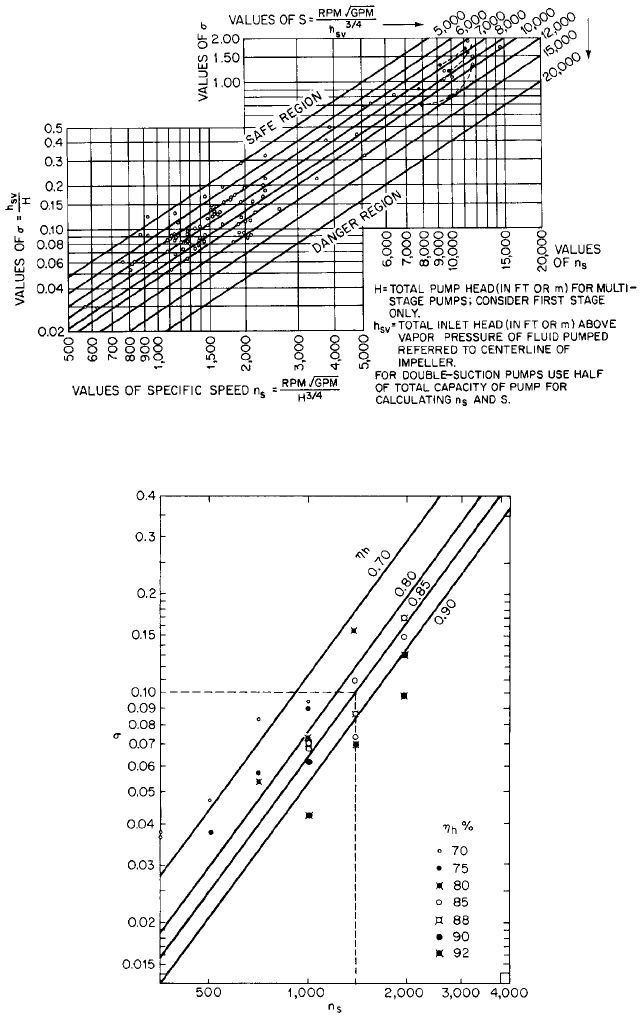
2.3.1 CENTRIFUGAL PUMPS: GENERAL PERFORMANCE CHARACTERISTICS 2.353
FIGURE 25 Cavitation limits of centrifugal and propeller pumps (Flowserve Corporation)
FIGURE 26 Cavitation parameter versus specific speed for different efficiencies (
s
= n
s
/2733) (Reference 13)
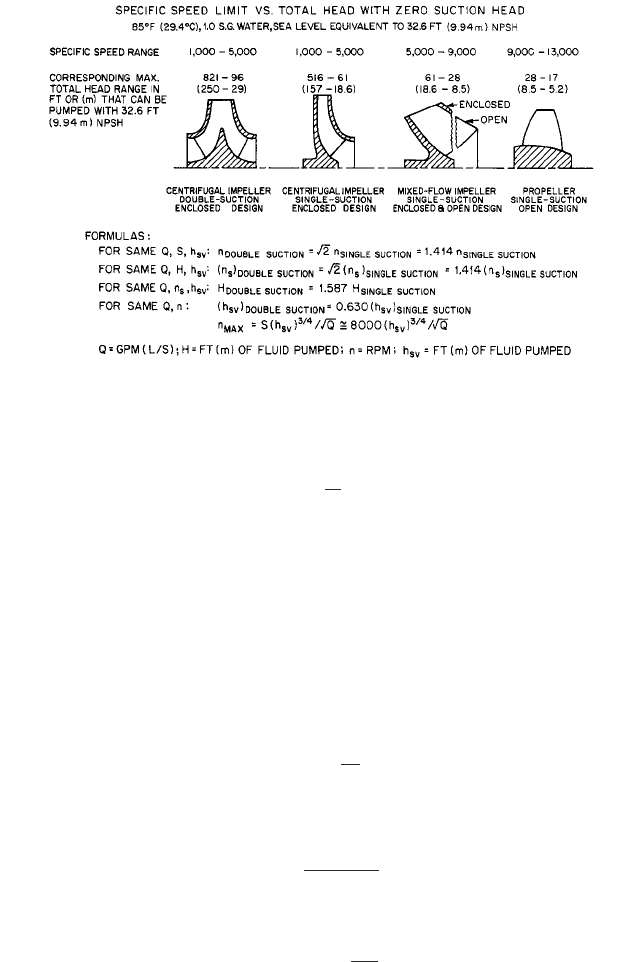
2.354 CHAPTER TWO
FIGURE 27 Commercial pumps applicable to zero suction head. Suction specific speed S = 8000 (
ss
= 2.93).
For centrifugal impellers, n
s
= 1,000-5,000 (
s
= 0.4-1.8); mixed-flow, 5,000-9,000 (1.8-3.3); propeller, 9,000-13,000
(1.3-4.8).
(20)
(21)
Figure 25 shows lines of constant S. For most pumps, 7500 6 S 6 11,000 (2.7 6
SS
6
4.0), S 8500 (3.11) being recommended by the Hydraulic Institute ANSI/HI 2000 Pump
Standards (Reference 27). Higher values may apply to special designs or service condi-
tions, such as an inducer ahead of the first-stage impeller. For a given specific speed, the
lower the value of S, the safer the pump against cavitation. Experience with large Euro-
pean pumped storage installations has shown that cavitation effects began at S 6000
(2.2), and this value is recommended for large pumps. Figure 27 shows a summary of data
and formulas that may be useful with commercial pumps.
German practice differs considerably from that in the United States in computing suc-
tion specific speed. Pfleiderer
1
defined a hub correction k as
(22)
where d
h
the hub diameter and D
o
the diameter of the suction nozzle, in any consis-
tent units. The suction specific speed S
G
is defined as
(23)
where n is measured in rpm, Q in cubic meters per second per impeller inlet, and h
sv
in
meters of liquid pumped. It follows that
(24)
NPSH for Liquids Other Than Cold Water Field experience, together with carefully
controlled laboratory experiments, has indicated that pumps handling hot water or cer-
S 51642S
G
k
S
G
1n>1002
2
Q
kh
sv
3>2
k 1 a
d
h
D
o
b
2
n
s
S1s2
3>4
s a
n
s
S
b
4>3
